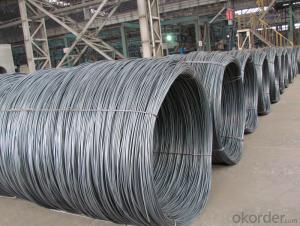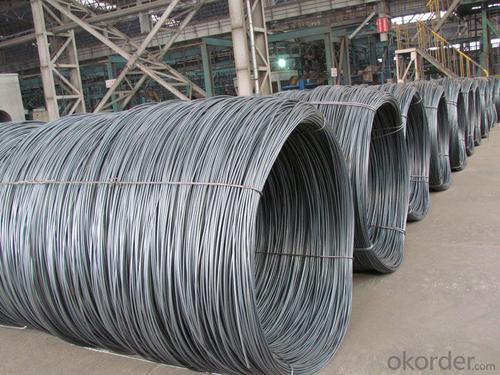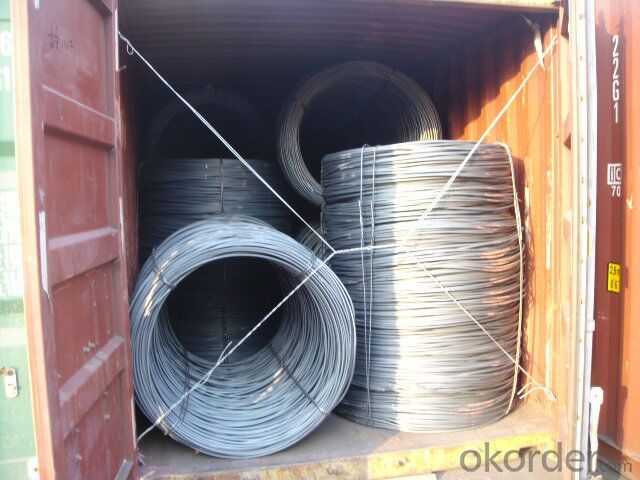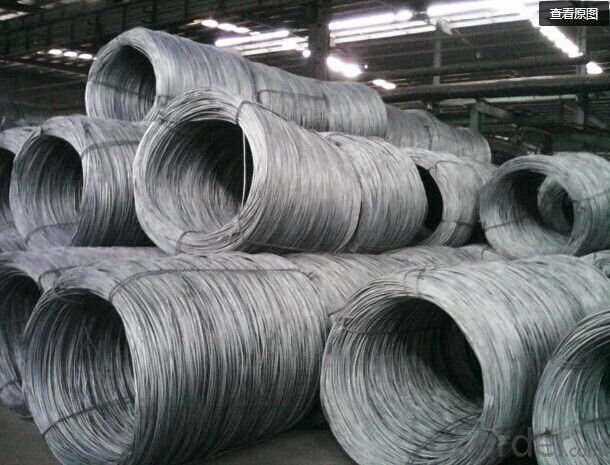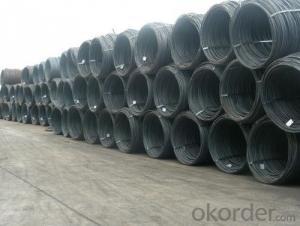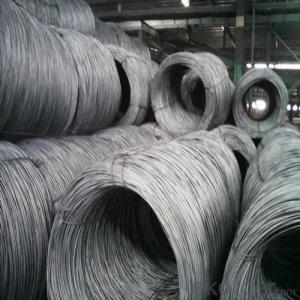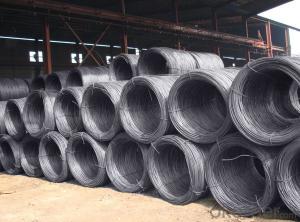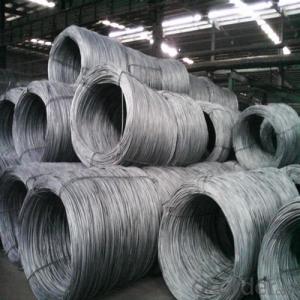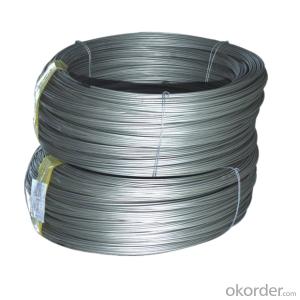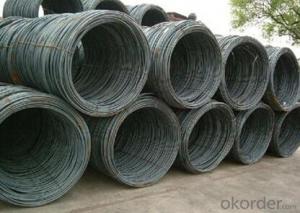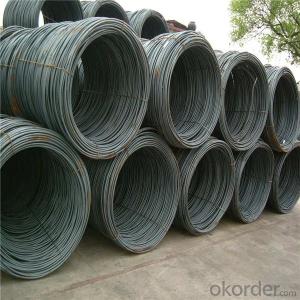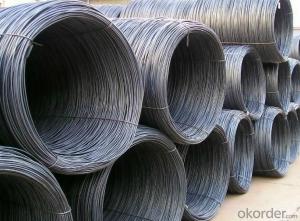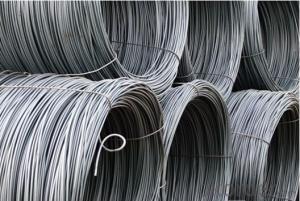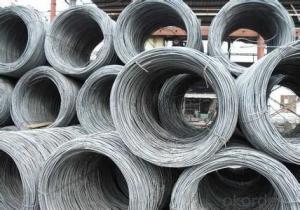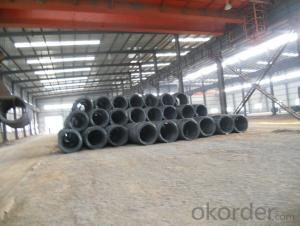Structure Steel Rod SAE1008B Steel Rod in Coils
- Loading Port:
- Tianjin
- Payment Terms:
- TT OR LC
- Min Order Qty:
- 30 m.t.
- Supply Capability:
- 20000 m.t./month
OKorder Service Pledge
OKorder Financial Service
You Might Also Like
Specification
Usage and Applications for Structure Steel Rod SAE1008B Steel Rod in Coils
The products are widely used in construction and manufacturing, mainly for reinforcement of reinforced concrete and
welded structure or reprocessed (roberts , nail, etc.) materials, especially used to produce wire drawing, welding
electrode, nails, spring, electronic, precise machinery parts and so on.
Specification for Structure Steel Rod SAE1008B Steel Rod in Coils
Steel Grade: Q195/235, SAE1006-1018B
Standard: ASTM, GB
Diameter: 5.5mm, 6.5mm, 7mm,8mm,9mm,10mm,12mm,14mm
Type: in coil, coil weight around 2MT
Alloy or Not: Alloy
Technique: Hot Rolled
Place of Origin: China Mainland
Surface: round, no twisted, light and smooth
Chemical Composition for Structure Steel Rod SAE1008B Steel Rod in Coils
Grade | Chemical Composition(%) | |||||
C | Mn | Si | S | P | B | |
SAE1006B | 0.03~O.07 | ≤0.32 | ≤0.30 | ≤0.045 | ≤0.040 | >0.0008 |
Mechanical properties | ||||||
Yield strength(N/mm2) | Tensile strength(N/mm2) | Elongation(%) | ||||
250-280 | 350-380 | ≥32 | ||||
Packaging and delivery for Structure Steel Rod SAE1008B Steel Rod in Coils
Packaging Detail: products are packed in coil, each coil weight around 2 MT, and then shipped by container or bulk vessel
Delivery Detail: within 45 days after received deposit or LC.
Label: to be specified by customer, generally, each bundle has 1-2 labels
Images for Structure Steel Rod SAE1008B Steel Rod in Coils
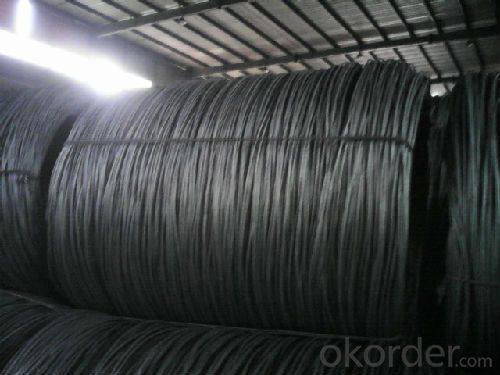
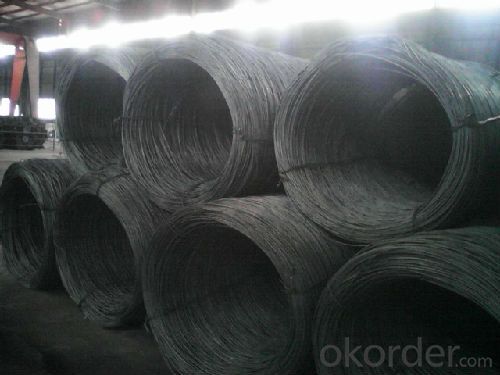
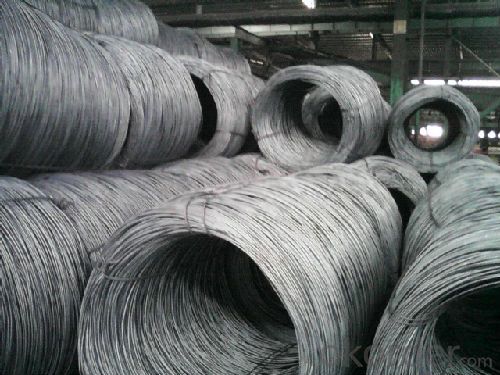
FAQ:
Q1: Why buy Materials & Equipment from OKorder.com?
A1: All products offered byOKorder.com are carefully selected from China's most reliable manufacturing enterprises. Through its ISO certifications, OKorder.com adheres to the highest standards and a commitment to supply chain safety and customer satisfaction.
Q2: How do we guarantee the quality of our products?
A2: We have established an advanced quality management system which conducts strict quality tests at every step, from raw materials to the final product. At the same time, we provide extensive follow-up service assurances as required.
Q3: How soon can we receive the product after purchase?
A3: Within three days of placing an order, we will begin production. The specific shipping date is dependent upon international and government factors, but is typically 7 to 10 workdays.
- Q: How is steel wire rod used in the manufacturing of wire for agricultural fences?
- Steel wire rod is an essential raw material in the manufacturing of wire for agricultural fences. It serves as the primary material that is drawn, twisted, and coated to create the final wire product. The high tensile strength and durability of steel wire rod make it ideal for withstanding the harsh conditions and stress that agricultural fences are subject to. Additionally, the flexibility of steel wire rod allows for easy installation and ensures that the wire can be securely fastened to fence posts.
- Q: How is steel wire rod used in the manufacturing of suspension wires for bridges?
- Steel wire rod is used in the manufacturing of suspension wires for bridges as it provides high strength and durability. The wire rod is first processed through various stages such as drawing, annealing, and galvanizing to enhance its properties. These processed wire rods are then further formed into suspension wires, which are used to support and stabilize the bridge structure. The strong and flexible nature of steel wire rod ensures that suspension wires can withstand heavy loads and vibrations, making it an essential component in bridge construction for maintaining structural integrity and ensuring safety.
- Q: What are the common production processes for oxygen-coated steel wire rod?
- The common production processes for oxygen-coated steel wire rod include wire drawing, cleaning and pickling, coating with oxygen, drying, and coiling.
- Q: How is steel wire rod used in the manufacturing of wire for suspension systems in vehicles?
- Steel wire rod is used in the manufacturing of wire for suspension systems in vehicles as it provides high strength and durability. It is first transformed into wire through a series of processes such as drawing, annealing, and coating. The resulting wire is then used to create various components of the suspension system, such as springs, sway bars, and control arms. The use of steel wire rod ensures that these suspension components can withstand the heavy loads and vibrations experienced during vehicle operation, contributing to a smooth and stable ride.
- Q: How is a steel wire rod manufactured?
- The production of a steel wire rod in a steel mill involves several steps. To start, impurities are removed and molten iron is created by melting iron ore in a blast furnace. This molten iron is then refined in a basic oxygen furnace (BOF) or an electric arc furnace (EAF). In the BOF or EAF, the molten iron is mixed with scrap steel and other alloying elements to achieve the desired composition and quality. This mixture undergoes high temperatures and chemical reactions, which help eliminate impurities and adjust the carbon content. Once the desired composition is achieved, the molten steel is cast into billets or blooms using continuous casting. These billets or blooms solidify into a semi-finished product, which is reheated to a rolling temperature. The reheated billet or bloom is then passed through a series of rolling mills. Initially, it goes through a roughing mill that reduces its size and shape. It then proceeds to a series of intermediate and finishing mills, which gradually decrease the cross-sectional area and refine the shape further. During the rolling process, the steel undergoes high pressure, elongating it and reducing its diameter. This continuous elongation and reduction in size enhance the strength and ductility of the wire rod. After the final rolling pass, the wire rod is cooled and wound onto a spool. It then undergoes various surface treatments, such as pickling or coating, to eliminate any mill scale or oxidation and enhance the surface quality. Finally, the wire rod is tested for its mechanical properties, dimensions, and surface quality. It is either shipped as a finished product to customers or further processed into different steel wire products, such as wires for construction, automotive, or industrial applications. In summary, the production of a steel wire rod involves a combination of melting, refining, casting, rolling, and surface treatment processes to manufacture a high-quality product with the desired properties.
- Q: What are the main factors affecting the recyclability of steel wire rod?
- The main factors affecting the recyclability of steel wire rod include the quality and composition of the steel, the presence of contaminants or coatings on the wire, and the efficiency and effectiveness of the recycling process used.
- Q: What are the different surface lubrication methods for steel wire rod?
- Some of the different surface lubrication methods for steel wire rod include dry drawing lubrication, oil-based lubrication, soap-based lubrication, and emulsion lubrication. These methods help to reduce friction and facilitate the wire drawing process, ensuring smooth and efficient production.
- Q: What are the different international specifications for steel wire rod?
- There are several different international specifications for steel wire rod, which outline the specific requirements and characteristics that the wire rod must meet. Some of the most commonly used international specifications for steel wire rod include: 1. ASTM A510: This specification covers general requirements for carbon steel wire rods and applies to both hot-rolled and cold-finished wire rods. 2. EN 10016-2: This European standard specifies the general requirements for non-alloy steel rod and wire for cold heading and cold extrusion. 3. JIS G 3505: This Japanese Industrial Standard covers low carbon steel wire rods for general use, including welding wire, nails, and wire ropes. 4. GB/T 699: This Chinese national standard defines the technical requirements for carbon structural steels, including wire rods. 5. ISO 16120-4: This international standard specifies the general requirements for steel wire rod, including dimensional tolerances, mechanical properties, and testing methods. Additionally, various industry-specific standards and specifications may exist for steel wire rod used in specific applications, such as automotive, construction, or electrical industries. These may include standards from organizations like SAE International or specific customer requirements. It is essential to consult the relevant specifications when manufacturing or sourcing steel wire rod to ensure compliance with the required standards and meet the specific needs of the intended application.
- Q: What are the main factors influencing the choice of steel wire rod payment terms?
- There are several main factors that can influence the choice of payment terms for steel wire rod. One of the primary factors is the financial stability and creditworthiness of the buyer. If the buyer has a strong financial position, the seller may be more willing to offer favorable payment terms, such as longer payment periods or installment payments. On the other hand, if the buyer has a poor credit history or financial instability, the seller may require stricter payment terms, such as upfront payment or shorter payment periods. The market conditions and competition can also impact the choice of payment terms. In a highly competitive market with multiple suppliers, the seller may need to offer more flexible payment terms to attract buyers. This could include options like deferred payment or payment upon delivery. Conversely, in a market with limited suppliers or high demand, the seller may have more leverage and can dictate stricter payment terms. The nature of the business relationship between the buyer and seller is another crucial factor. If the buyer and seller have a long-standing relationship with a history of successful transactions, the seller may be more willing to offer favorable payment terms as a gesture of trust and loyalty. Additionally, the volume and frequency of purchases can also influence the payment terms. Buyers who consistently purchase large quantities of steel wire rod may have more negotiating power and be able to secure more favorable payment terms. Lastly, external factors such as economic conditions, currency fluctuations, and government regulations can also impact the choice of payment terms. In times of economic uncertainty or currency volatility, sellers may be more cautious and require stricter payment terms to mitigate their risk. Similarly, government regulations related to international trade or finance can also affect the choice of payment terms. Overall, the main factors influencing the choice of payment terms for steel wire rod include the financial stability of the buyer, market conditions, the nature of the business relationship, and external factors such as economic conditions and government regulations.
- Q: What are the main factors influencing the supply and demand of steel wire rod?
- There are several main factors that influence the supply and demand of steel wire rod. 1. Economic growth: The overall economic growth of a country or region plays a significant role in determining the demand for steel wire rod. When the economy is growing, there is typically an increase in construction and infrastructure projects, which drives up the demand for steel wire rod. 2. Construction and infrastructure projects: The construction industry is one of the major consumers of steel wire rod. The demand for steel wire rod is influenced by the number and scale of construction and infrastructure projects, such as buildings, bridges, roads, and railways. The more construction projects there are, the higher the demand for steel wire rod. 3. Automotive industry: The automotive industry is another major consumer of steel wire rod. The demand for steel wire rod in this industry is influenced by factors such as consumer demand for automobiles, technological advancements, and government regulations related to automotive safety and emissions. The production of automobiles requires steel wire rod for various components, including suspension systems, engine parts, and reinforcements. 4. Manufacturing sector: The demand for steel wire rod is also influenced by the overall manufacturing sector. Steel wire rod is used in various manufacturing processes and industries, such as machinery, appliances, electrical equipment, and furniture. The level of manufacturing activity and the demand for goods produced by these industries affect the demand for steel wire rod. 5. Raw material availability and cost: The supply of steel wire rod is influenced by the availability and cost of raw materials, particularly iron ore and scrap metal. Changes in the availability or cost of these raw materials can impact the production and supply of steel wire rod. Additionally, fluctuations in energy prices, transportation costs, and other input costs can also affect the supply of steel wire rod. 6. International trade and tariffs: Global steel wire rod supply and demand are influenced by international trade and tariffs. Trade policies and tariffs imposed by countries can impact the import and export of steel wire rod, which in turn affects the supply and demand dynamics. Trade disputes and protectionist measures can disrupt the global steel wire rod market and create uncertainties in supply and demand. Overall, the supply and demand of steel wire rod are influenced by economic growth, construction and infrastructure projects, the automotive industry, the manufacturing sector, raw material availability and cost, and international trade and tariffs. These factors interact with each other and can fluctuate over time, leading to changes in the supply and demand dynamics of steel wire rod.
Send your message to us
Structure Steel Rod SAE1008B Steel Rod in Coils
- Loading Port:
- Tianjin
- Payment Terms:
- TT OR LC
- Min Order Qty:
- 30 m.t.
- Supply Capability:
- 20000 m.t./month
OKorder Service Pledge
OKorder Financial Service
Similar products
Hot products
Hot Searches
Related keywords
